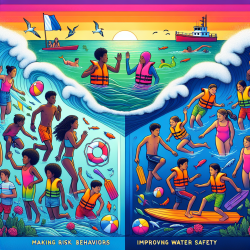Introduction
Water safety is a critical concern for adolescents, especially given the alarming statistics surrounding drowning incidents. The research article "Adolescent Water Safety Behaviors, Skills, Training and Their Association with Risk-Taking Behaviors and Risk and Protective Factors" provides valuable insights into how practitioners can improve water safety outcomes for adolescents. This blog will explore the key findings of the study and suggest practical applications for enhancing water safety education and interventions.
Understanding the Risks
The study highlights that drowning is the third leading cause of unintentional injury death among adolescents in the United States. Factors such as peer pressure, developmental stages, and engagement in risk-taking behaviors contribute to the high drowning rates among teens. The research utilized data from the 2014 Washington State Healthy Youth Survey (HYS) to analyze adolescents' swimming lessons, life jacket use, and comfort in deep water.
Key Findings
- 60.4% of students reported having had formal swimming lessons, with disparities noted based on race, ethnicity, and socioeconomic status.
- 56.7% of students reported wearing life jackets while boating, with females and younger students more likely to wear them.
- Comfort in deep water was reported by 86.7% of students, with significant differences based on race and maternal education.
Implications for Practitioners
Practitioners can leverage these findings to enhance water safety education and interventions. Here are some recommendations:
- Promote Inclusive Swimming Programs: Address racial, ethnic, and socioeconomic disparities by ensuring access to swimming lessons for all communities.
- Enhance Life Jacket Education: Emphasize the importance of life jacket use, especially for older adolescents who may underestimate water hazards.
- Engage Families and Communities: Encourage family involvement in water safety education to reinforce protective factors and reduce risk-taking behaviors.
Encouraging Further Research
The study underscores the need for further research to explore the complex relationships between risk-taking behaviors, protective factors, and water safety skills. Practitioners are encouraged to conduct multivariate analyses to identify key determinants of water safety behaviors among diverse adolescent populations.
Conclusion
By understanding the factors influencing adolescent water safety behaviors, practitioners can develop targeted interventions to reduce drowning risks. The insights from this study provide a foundation for promoting water safety education and fostering positive outcomes for adolescents.
To read the original research paper, please follow this link: Adolescent Water Safety Behaviors, Skills, Training and Their Association with Risk-Taking Behaviors and Risk and Protective Factors.










